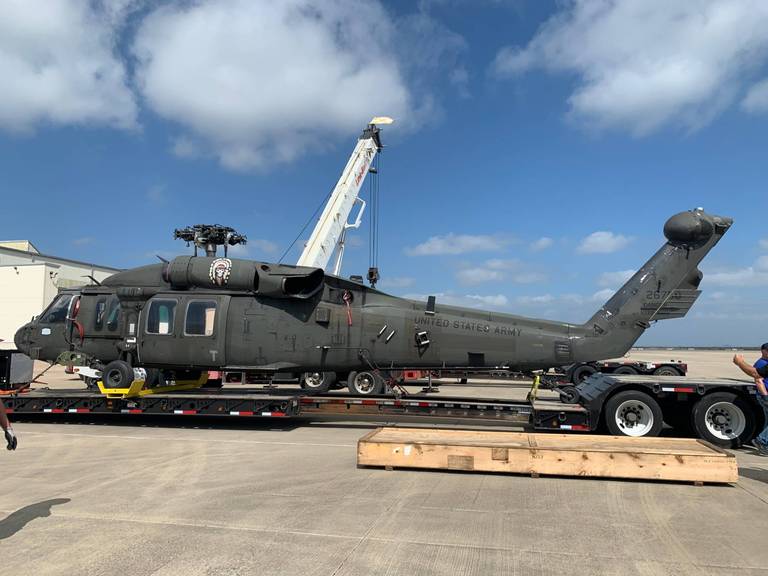A recent collaboration between U.S. Army Aviation and Missile Command and Wichita State University will enhance the helicopter fleet for this division of the military. Researchers from the National Institute for Aviation Research are currently working with both organizations to dismantle a UH-60L Black Hawk for the purposes of making a digital replica.
NIAR researchers will begin by 3D scanning parts and, while this is an undertaking in itself, they must first take apart components like the airframes from a helicopter that is operational. For this project, a separate fuselage is also being delivered to the University from Corpus Christi Army Depot. The focus is the Lima helicopter model, which has actually been out of production for the past 15 years, although some parts are as old as 40 years.

Wichita State University researchers will disassemble a UH-60L Black Hawk helicopter to capture a 3D scan of each structural part. (Image: Wichita State University)
“Digital-twin technology provides a virtual environment that facilitates the crawl, walk, run training philosophy that enables Soldiers to develop confidence in a simulated environment before performing the task on an actual aircraft,” said AMCOM Command Sgt. Maj. Mike Dove. “Virtual environments enable a task to be taught through distance learning with the subject matter expert thousands of miles away.”
While knowledge of 3D printing may still be relatively new to the general public, it is hardly a novelty to the military or other organizations, like NASA, who have been making use of additive manufacturing processes for decades whether for rapid prototyping or functional—and critical—parts.
The benefits of such technology are evidenced in full force for this recent project, offering huge savings on the bottom line in terms of maintenance for the U.S. Army Aviation and Missile Command, but also fast production, the potential for creating parts that are lighter and offer better performance, as well as the opportunity for making items that may not have even been previously possible with traditional methods.
As obsolescence becomes a problem for other divisions of the military, too, trying to keep up with equipment maintenance and repairs, some parts may be difficult to find, taking months to track down, or they may not even be available at all anymore. 3D printing offers much more than a quick fix. By 3D scanning parts of older machines, industrial users are able to replicate items that may have become outdated—offering indefinite longevity to aging fleets.
Modifications can easily be made, and quickly so. This is true also for automotive applications, train manufacturers, and other divisions of the military as they work to keep equipment like Navy ships properly maintained.
“The intent is to enable readiness across the Army and the UH-60 fleets in the joint service and the applicable foreign military sales environment,” AMCOM Commander Maj. Gen. Todd Royar said in a statement. “At the same time, we generate new opportunities to provide parts that are obsolete, low-volume or small quantity. The result is reduced operation and sustainment costs.”
“It takes this team of teams’ approach that will benefit not just the military but also academia and industry.”
Officials stated in a recent press release that the purpose of re-creating helicopter parts with 3D scanning and 3D printing for better maintenance will ‘resolve challenges and boost efficiencies’ for aircraft like the Black Hawk, and the Lima model.
“Our goal is to develop a prototype capability which will transition into not just existing platforms within the Department of Defense but identify the digital engineering requirements for future platform development,” said Maj. Sam Gray, Program Manager for the Strategic Capabilities Office. “It will be of great benefit to the Army if we can reduce sustainment costs and increase readiness for the UH-60L. This is a unique opportunity to bring a game-changing technology to the sustainment and logistics fields.”

Sen. Jerry Moran, R-Kansas, said that Secretary of State Mike Pompeo would be a “solid candidate” for the Senate seat of retiring Republican Pat Roberts. Moran was at a Wichita event with Acting Secretary of the Army Ryan McCarthy. (Sept. 5, 2019). Image: Wichita Eagle.
What do you think of this news? Let us know your thoughts; join the discussion of this and other 3D printing topics at 3DPrintBoard.com.
[Source / Images: Wichita State University; Wichita Eagle]Subscribe to Our Email Newsletter
Stay up-to-date on all the latest news from the 3D printing industry and receive information and offers from third party vendors.
You May Also Like
New Report: Semiconductor Industry to See $1.4B in 3D Printing Revenues by 2032
“The semiconductor sector has become the most strategically significant area of global industry.” Truer words are hard to come by when it comes to the modern world, and they are...
Will Photonic-Crystal Lasers Revolutionize 3D Printing?
Powder bed fusion (PBF) for metals and polymers predominantly utilizes lasers as the primary heat source. Some directed energy deposition (DED) technologies also employ lasers, while various vat polymerization methods...
3D Printing Unpeeled: Orbex Investment, IndoMIM and HP, Ultrasonic Waves
INDO-MIM has bought three HP Metal Jet S100 printers, operating two in India and one in Texas. This is a win for HP because the company has deep experience in...
3D Printing Webinar and Event Roundup: April 21, 2024
It’s another busy week of webinars and events, starting with Hannover Messe in Germany and continuing with Metalcasting Congress, Chinaplas, TechBlick’s Innovation Festival, and more. Stratasys continues its advanced training...































